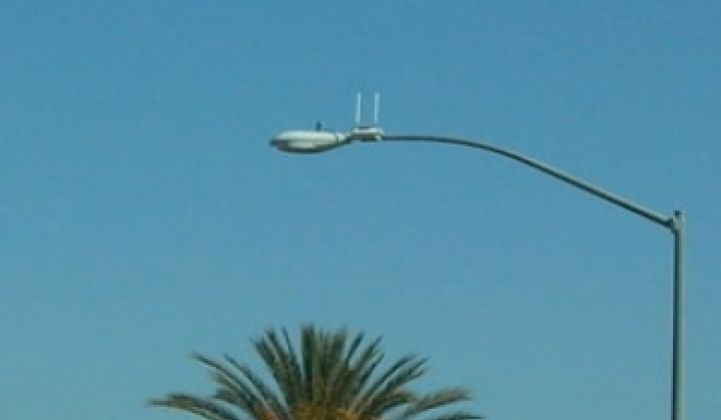A city that has installed its own WiFi network might as well let its municipal utility use it. That's the logic behind Tropos Networks‘ growth into the smart grid business.
The Sunnyvale, Calif.-based municipal WiFi networking startup has seen a number utilities use the networks it has installed over the years, including as a way to link the devices that aggregate data from thousands of two-way communicating "smart meters" with the utilities' back-office systems.
Given that those smart meters are now being installed in the millions, that's a growth business. That's where Tropos' GridCom architecture – the name Tropos has given for its utility-specific offering – comes in.
But while GridCom was officially unveiled Tuesday, working with utilities is something Tropos has been doing for quite awhile, said Rob Pilgrim, vice president of business and corporate development.
"We've seen it become a significant percentage of our business, and it's a huge proportion of our pipeline," he said. Tropos now has about a dozen utilities using its WiFi networks for so-called smart meter aggregation, he said.
While WiFi is seen as too expensive and power-hungry to serve as a cost-effective communications technology for individual meters, it does make sense as an aggregation network in denser, more urban areas, said Ben Schuman, an analyst with Pacific Crest Securities.
Denise Barton, Tropos' marketing director, said the company has partnerships with major smart meter makers Itron, Elster and Echelon, and is serving about 300,000 meters today, a number that's expected to climb to 1 million by year's end, said
The few utilities Tropos has named as customers are municipal utilities, including Anderson (Ind.) Municipal Light and Power, Lafayette (La.) Utilities System and Burbank (Calif.) Water and Power (see Reading Electric Meters Wirelessly).
But at least two of its utility customers are outside the United States, and several are larger investor-owned utilities, some with plans to install millions of meters, Pilgrim said.
He wouldn't name those utilities, but it's possible that Duke Energy may be one.
David Mohler, Duke's chief technology officer, has told Greentech Media that Duke is planning to include WiFi in its suite of technologies to link smart meters with the utility, though he wouldn't say which company was providing the WiFi service.
Of course, Duke and other utilities are also looking at a host of other communications technologies to bridge the gap between smart meter aggregators and utility "backhaul" networks.
Take cellular networks. KORE Telematics uses AT&T's wireless network to connect the 800,000 smart meters being installed by utility Arizona Public Service to the utility's "backhaul" system. Verizon is working with Duke on a similar project, and has been working with Itron for some time to fill that need (see Green Light post).
And AT&T is working with smart meter networking company SmartSynch to bring communications directly to smart meters (see Your Electrical Meter Becomes a Cell Phone).
Then there's WiMax, the powerful, long-range wireless technology that is being deployed by a Sprint-Clearwire partnership aimed at building a nationwide network.
While no utilities have opted to use that network, General Electric is deploying its own WiMax-based aggregator-to-utility backhaul network for CenterPoint Energy in Texas (see GE Offers WiMax Smart Meter Solution).
Grid Net, a San Francisco startup that makes WiMax Internet routers for smart meters made by GE, is hoping to see its system taken up by utilities including SP AusNet and Energy Australia in Australia and American Electric Power (AEP) and Consumers Energy in the United States, a spokeswoman said last month.
Broadband over powerline - a technology for carrying data over transmission lines - is also being deployed as a way to carry meter data back to utilities (see Broadband Over Powerline Brings Smart Grid to Rural Areas).
And Hughes Network Systems is now offering its combination satellite and land-based communications network to utilities, though it isn't concentrating on linking smart meters (see Hughes Offers Utility Communications).
Of course, it's possible that other companies in the municipal WiFi field may see the same utility opportunities that Tropos is pursuing - and Cisco Systems has been building municipal WiFi networks since 2005.
Cisco has already announced plans to incorporate energy management features into WiFi access points and other devices within buildings, and could see outdoor WiFi networks as another opportunity (see Cisco Jumps Into Energy Management for Computers, Buildings).
In fact, in 2006 Cisco was picked by Cellnet Technology (now part of smart meter maker Landis+Gyr) to provide WiFi mesh technology for a Madison, Wisc. project called Mad City Broadband that included wireless meter reading.
While Schuman said he wasn't aware of a big push into utility networking by other municipal WiFi developers, including Cisco, the networking giant "can always wait and see where markets develop, and then buy in later."
Tropos' Pilgrim conceded that Cisco could move aggressively into the field, but said he believed Tropos has developed technology that's better suited for outdoor applications.
Tropos has received investments from Benchmark Capital, Boston Millennia Partners, Integral Capital Partners, the Intel Communications Fund, Duff Ackerman & Goodrich, Hanna Ventures, Siemens Venture Capital, Voyager Capital and WK Technology Fund.
While Tropos would not say how much total investment it has received, news sources have stated that Tropos had received $9.3 million as of June 2003, and $28.5 million as of September 2005.



